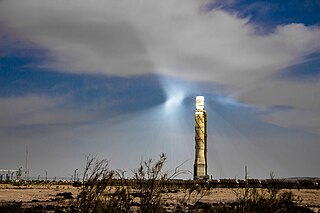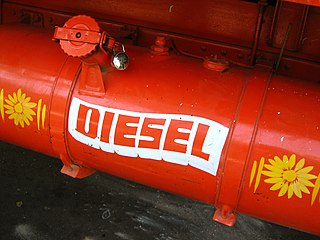
A power station, also referred to as a power plant or powerhouse and sometimes generating station or generating plant, is an industrial facility for the generation of electric power. Most power stations contain one or more generators, a rotating machine that converts mechanical power into electrical power. The relative motion between a magnetic field and a conductor creates an electrical current. The energy source harnessed to turn the generator varies widely. Most power stations in the world burn fossil fuels such as coal, oil, and natural gas to generate electricity. Others use nuclear power, but there is an increasing use of cleaner renewable sources such as solar, wind, wave and hydroelectric.

Solar thermal energy (STE) is a form of energy and a technology for harnessing solar energy to generate thermal energy or electrical energy for use in industry, and in the residential and commercial sectors.

In electric power generation a combined cycle power plant is an assembly of heat engines that work in tandem from the same source of heat, converting it into mechanical energy, which in turn usually drives electrical generators. The principle is that after completing its cycle, the temperature of the working fluid in the system is still high enough that a second subsequent heat engine extracts energy from the heat that the first engine produced. By combining these multiple streams of work upon a single mechanical shaft turning an electric generator, the overall net efficiency of the system may be increased by 50–60%. That is, from an overall efficiency of say 34%, to possibly an overall efficiency of 62%, 84% Theoretical efficiency

Cogeneration or combined heat and power (CHP) is the use of a heat engine or power station to generate electricity and useful heat at the same time. Trigeneration or combined cooling, heat and power (CCHP) refers to the simultaneous generation of electricity and useful heating and cooling from the combustion of a fuel or a solar heat collector. The terms cogeneration and trigeneration can be also applied to the power systems generating simultaneously electricity, heat, and industrial chemicals – e.g., syngas or pure hydrogen.

Micro combined heat and power or micro-CHP or mCHP is an extension of the idea of cogeneration to the single/multi family home or small office building in the range of up to 50 kW. Local generation has the potential for a higher efficiency than traditional grid-level generators since it lacks the 8-10% energy losses from transporting electricity over long distances. It also lacks the 10–15% energy losses from heat transfer in district heating networks due to the difference between the thermal energy carrier and the colder external environment. The most common systems use natural gas as their primary energy source and emit carbon dioxide.

Nevada Solar One is a concentrated solar power plant, with a nominal capacity of 64 MW and maximum steam turbine power output up to 72 MW net (75 MW gross), spread over an area of 400 acres (160 ha). The projected CO2 emissions avoided is equivalent to taking approximately 20,000 cars off the road. The project required an investment of $266 million USD, and the project officially went into operation in June 2007. Electricity production is estimated to be 134 million kilowatt hours per year.

There are several solar power plants in the Mojave Desert which supply power to the electricity grid. Insolation in the Mojave Desert is among the best available in the United States, and some significant population centers are located in the area. These plants can generally be built in a few years because solar plants are built almost entirely with modular, readily available materials. Solar Energy Generating Systems (SEGS) is the name given to nine solar power plants in the Mojave Desert which were built in the 1980s, the first commercial solar plant. These plants have a combined capacity of 354 megawatts (MW) which made them the largest solar power installation in the world, until Ivanpah Solar Power Facility was finished in 2014.

Concentrated solar power systems generate solar power by using mirrors or lenses to concentrate a large area of sunlight onto a small area. Electricity is generated when the concentrated light is converted to heat, which drives a heat engine connected to an electrical power generator or powers a thermochemical reaction.
Archimede combined cycle power plant is an integrated solar combined cycle (ISCC) power generation plant at Priolo Gargallo near Syracuse in Sicily, Italy. The combine cycle section was inaugurated in 2003, and the solar field on 14 July 2010. The solar field is the first to use molten salt for heat transfer and storage which is integrated with the combined-cycle gas facility. It uses technology developed by ENEA and Archimede Solar Energy, a joint venture between Angelantoni Industrie and Siemens Energy. Archimede is owned and operated by Enel.

The solar power tower, also known as 'central tower' power plants or 'heliostat' power plants or power towers, is a type of solar furnace using a tower to receive the focused sunlight. It uses an array of flat, movable mirrors to focus the sun's rays upon a collector tower. Concentrated solar thermal is seen as one viable solution for renewable, pollution-free energy.

eSolar is a privately held company that develops concentrating solar power (CSP) plant technology. The company was founded by the Pasadena-based business incubator Idealab in 2007 as a developer of CSP plant technology. The company aims to develop a low cost alternative to fossil fuels through a combination of small heliostats, modular architecture, and a high-precision sun-tracking system. In October 2017, an article in GreenTech Media suggested that eSolar ceased business in late 2016.

The use of solar energy began in Israel in the 1950s with the development by Levi Yissar of a solar water heater to address the energy shortages that plagued the new country. By 1967 around 5% of water of households was solar heated and 50,000 solar heaters had been sold. With the 1970s oil crisis, Harry Zvi Tabor developed the prototype of the solar water heater now used in over 90% of Israeli homes. There are over 1.3 million solar water heaters installed as a result of mandatory solar water heating regulations.

A hybrid turbocharger is an electric turbocharger consisting of a high speed turbine-generator and a high speed electric air compressor. The turbine and compressor are high-speed aeromachines, as in a conventional turbocharger. The electrical motors run at speeds in excess of 120,000 rpm and when used as generators, generate electricity at up to 98.5% electrical efficiency. High electrical efficiency is paramount, because there is no mechanical link between the turbine and compressor. In other words, hybrid turbocharger refers to a series hybrid setup, in which compressor speed and power are independent from turbine speed and power. This design flexibility leads to further improvements in turbine and compressor efficiency, beyond a conventional turbocharger.

The Ivanpah Solar Electric Generating System is a concentrated solar thermal plant in the Mojave Desert. It is located at the base of Clark Mountain in California, across the state line from Primm, Nevada. The plant has a gross capacity of 392 megawatts (MW). It deploys 173,500 heliostats, each with two mirrors focusing solar energy on boilers located on three centralized solar power towers. The first unit of the system was connected to the electrical grid in September 2013 for an initial synchronisation test. The facility formally opened on February 13, 2014. In 2014, it was the world's largest solar thermal power station.

Sierra SunTower was a 5 MW commercial concentrating solar power (CSP) plant built and operated by eSolar. The plant is located in Lancaster, California. As of mid-August, 2018, the two towers that were the center of the facility are no longer standing. The plant, however, is still present.

The Ashalim power station is a solar power station in the Negev desert near the kibbutz of Ashalim, in Israel. It has the tallest solar power tower in the world at a height of 260 meters including the boiler, concentrating 50,600 computer-controlled heliostats.
The following outline is provided as an overview of and topical guide to solar energy:
Termosolar Borges is a hybrid biomass-parabolic trough solar thermal power plant which provides electricity to Spain's transmission system. It is located about 100 kilometres (62 mi) west of Barcelona, about 10 kilometres (6.2 mi) south-east of Lleida, near Les Borges Blanques, Catalonia, Spain.




















